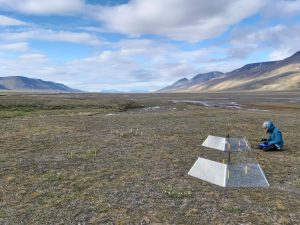Predicting ecosystems responses to changing environmental conditions is one of the most pressing challenges in ecology today. In the past few decades, mean annual temperatures in the Arctic have risen by 2-4 ºC while rain-on-snow events are becoming more frequent. Other environmental changes can be seen in a drastic increase in the goose population. All of these changes may have repercussions on C and N cycling as well as microbial functional diversity and activity in the soil.
Project description

The aim of this project is to establish an experiment in Adventdalen that will investigate warming, icing events and grubbing events. The experiment will compare two different plant communities, a mesic Dryas-dominated heath and a moss-dominated tundra.
Tasks
The student will join the on-going TERRA project. You will assist with field work. Depending on when you join, this can entail several tasks.
From Feb onwards, snow depth and snow melt will be measured. In June, open top chambers and exclosures will be set out in the tundra. Grubbing will be artificially simulated. During summer (June – August) we will harvest and clean litter bags, download data from dataloggers, and install a new experiment involving mesh ingrowth bags that will be incubated for one year. We will also take soil cores, sort roots, and extract soil dwelling animals from cores. In October to November, we will get the experiment ready for winter (mark plots, storage OTCs and exclosures), and check for damage by reindeer. Polar bear watch will also be a part of field work.
The project involves: Field work
Starting date/period: possible from beginning of February to end of November
Prerequisites: Able to carry and handle a rifle. Basic knowledge in ecology.
Experience/skills to be acquired
The student will gain some knowledge on how to establish an experiment as well as how to conduct abiotic measurements in the field. Depending on timing, the students may also gain some knowledge in plant species identification. The student will also learn how to operate in a high Arctic environment where polar bears can be present.
Involvement
Flexible (max 40h). It is recommended to work at least 7 h/day when being in the field.
Interested in this project or need more info? Contact:
Simone Lang (simonel@unis.no), Emelie Winquist (emeliew@unis.no)
Project number: 25
